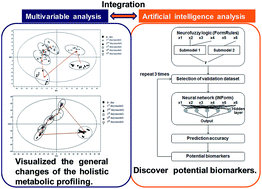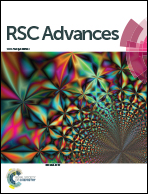Urinary metabolomics study on an induced-stress rat model using UPLC-QTOF/MS†
Abstract
A urinary metabolomics method based on ultra-performance liquid chromatography coupled with quadrupole/time-of-flight mass spectrometry (UPLC-QTOF/MS) was employed to investigate the pathogenesis and therapeutic effects of a Baixiangdan capsule on rats undergoing electric-induced stress for five days. Multivariate analysis techniques, such as principal component analysis (PCA) and partial least squares discriminant analysis (PLS-DA), were applied to observe the temporal changes in the metabolic state of the electric-stressed rats visually, as well as the recovering tendency of the rats treated with the Baixiangdan capsule. Artificial intelligence technology (artificial neural networks and neurofuzzy logic) was used to identify potential biomarkers, and the results showed a high overlap with the PLS-DA model. A total of 14 potential biomarkers representing the major cause–effect relationships between the variations in the endogenous metabolites and the dynamic pathological processes associated with the stress induced by the electric stimulation were identified, including amino acid metabolites, such as 2-aminoadipic acid, hippuric acid, spermine, 4-hydroxyglutamate and L-phenylalanine, in addition to prostaglandin F3a and melatonin. The results indicated that the pathways corresponding to L-phenylalanine, tyrosine, tryptophan, arginine, proline metabolism, pantothenic acid, and coenzyme A synthesis were disturbed in the electric-stressed rats, and that the application of the Baixiangdan capsule may regulate the aforementioned metabolic pathways back to their initial states. The application of artificial intelligence technologies provided powerful and promising tools to model complex metabolomic data and to discover hidden knowledge regarding the potential biomarkers associated with the development of disease, which are also suitable for other complex biological data sets.


 Please wait while we load your content...
Please wait while we load your content...